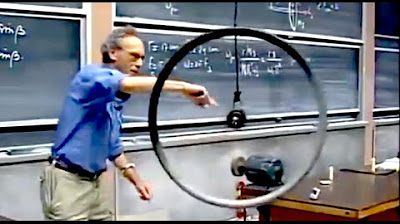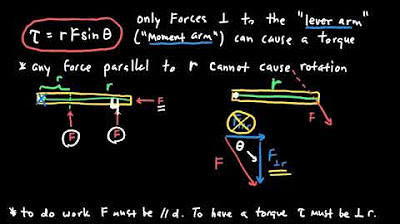Angular Momentum - Physics 101 / AP Physics 1 Review with Dianna Cowern
TLDRIn this engaging physics lesson, Diana Cowan explores the concept of angular momentum, using illustrative experiments with spinning pipes and water to demonstrate how spinning objects maintain their motion. She connects this to the feeling of dizziness when spinning, attributing it to the continuing rotation of fluid in the head after stopping. The lesson delves into the mathematical models of rotation, introducing torque, moment of inertia, and their relationship to linear motion concepts. Cowan also discusses the conservation of angular momentum and its implications on a grand scale, such as the spinning of neutron stars, making complex physics principles accessible and fascinating.
Takeaways
- 💡 The property of spinning objects to keep spinning is called angular momentum.
- 🌀 Angular momentum is similar to the momentum of a fast-moving car, but for spinning motion.
- 📐 Torque, the rotational equivalent of force, causes a change in an object's rotational speed.
- 🔄 The moment of inertia is the rotational analog of mass and determines how easily an object spins.
- 📊 The moment of inertia (I) can be calculated using the formula I = mr², where m is mass and r is the radius.
- 🔽 The farther away from the axis of rotation, the greater the linear speed and the greater the need for torque.
- 🎾 For a spinning record, the moment of inertia must be calculated by summing the moments of inertia of all the tiny pieces.
- 🌍 The Earth's rotation is an example of angular momentum in action, and it will continue spinning until acted upon by an external force.
- 🏃 Humans running around the Earth's equator could theoretically change its spin speed, but the effect would be minuscule.
- 🌋 Large earthquakes can have a noticeable effect on Earth's rotation, as seen with the 2011 earthquake in Japan.
- 🌟 Supernovae and the resulting neutron stars demonstrate the conservation of angular momentum on a cosmic scale.
Q & A
What is the main concept discussed in the video?
-The main concept discussed in the video is angular momentum and its relation to spinning objects, including the conservation of angular momentum and how it applies to various physical scenarios.
How does the video introduce the topic of angular momentum?
-The video introduces the topic of angular momentum through a series of demonstrations involving water shooting out of pipes and the effects of spinning, such as feeling dizzy after spinning around.
What is the rotational analog of linear momentum?
-The rotational analog of linear momentum is the moment of inertia, which quantifies the resistance of an object to rotational acceleration.
What is the formula for torque in the context of rotational motion?
-The formula for torque in the context of rotational motion is torque equals the moment of inertia (I) times the angular acceleration (Alpha).
Why do spinning objects tend to keep spinning?
-Spinning objects tend to keep spinning due to the property of angular momentum, which states that an object in rotation will continue to rotate unless acted upon by an external torque.
What is the relationship between linear velocity and angular velocity?
-The relationship between linear velocity (V) and angular velocity (Omega) is given by the equation V = R * Omega, where R is the radius of rotation.
How does the shape of an object affect its moment of inertia?
-The shape of an object significantly affects its moment of inertia, with extended shapes like hoops having a higher moment of inertia compared to compact shapes like spheres, due to the distribution of mass relative to the axis of rotation.
What is the conservation of angular momentum in the context of the video?
-In the context of the video, the conservation of angular momentum refers to the principle that the angular momentum of a system remains constant unless acted upon by an external torque, as demonstrated by the spinning water pipes and the aerialist's movements.
How does the video illustrate the conservation of angular momentum with the example of a rolling spherical cow versus a sliding box cow?
-The video illustrates the conservation of angular momentum by showing that the box cow, which does not have to expend energy on rotation, reaches the bottom of a ramp first, despite the spherical cow's tendency to rotate and gain speed quickly.
What is the role of angular momentum in the formation of pulsars?
-Angular momentum plays a crucial role in the formation of pulsars as massive stars collapse into neutron stars, conserving their angular momentum, which results in the extremely fast rotation of these compact objects, emitting beams of light as they spin.
What would be the effect of all humans running around the Earth's equator in the same direction on the Earth's rotation speed?
-If all humans ran around the Earth's equator in the same direction, they could theoretically change the Earth's rotation speed, but the effect would be minuscule, amounting to less than 0.0003% of the Earth's rotation speed, as calculated in the video.
Outlines
💧 The Intuitive Water Spout Experiment
This paragraph introduces a simple water spout experiment to demonstrate the principles of motion and rotation. Initially, a spout with tubes is used to show how water flows straight out when turned on. The experiment then progresses by spinning the pipes to observe the change in the water's trajectory, noting that the water curves and trails behind. The segment ends with the introduction of Diana Cowan and the context of the lesson on angular momentum, relating the physical phenomena observed in the water experiment to the concept of spinning objects and dizziness experienced by humans.
🌀 Understanding Angular Momentum and Inertia
The second paragraph delves into the physics concepts of angular momentum and moment of inertia. It explains how spinning objects, such as a top or the Earth, tend to keep spinning due to angular momentum. The lesson continues with an exploration of the moment of inertia, which is analogous to mass in linear motion, and how it varies with the shape and mass distribution of an object. The concept is further illustrated with examples of different objects and their ease of spinning, leading to the introduction of the equation that relates torque, moment of inertia, and angular acceleration.
🏋️♀️ The Aerialist's Conservation of Angular Momentum
This paragraph showcases a demonstration of the conservation of angular momentum by an aerialist, Thea Ulrich. It explains how changing the position of her limbs affects her rotational speed, illustrating the relationship between moment of inertia, angular velocity, and linear speed. The aerialist's movements are used to explain the conservation of angular momentum in a tangible way, emphasizing that angular momentum must be conserved in the absence of external torque. The segment also touches on the concept of energy transfer between potential and kinetic forms in the context of rolling and sliding objects.
🌍 The Earth's Angular Momentum and Spin
The fourth paragraph discusses the angular momentum of the Earth and how it is affected by human actions and natural events. It uses the concept of angular momentum to answer the hypothetical question of whether all people running around the Earth's equator could change its spin speed. The explanation involves calculations of moment of inertia for a group of people and the Earth, and the resulting change in Earth's angular velocity is found to be negligible. The paragraph also mentions the impact of large earthquakes on Earth's rotation, highlighting the vast difference in scale between natural and human-induced effects.
🌟 Pulsars and the Cosmic Display of Angular Momentum
The final paragraph wraps up the lesson with a focus on the cosmic significance of angular momentum. It introduces the concept of pulsars, which are neutron stars that spin rapidly due to the conservation of angular momentum from their progenitor stars. The extreme spinning of these stars results in regular pulses of light observable from Earth, leading to their initial misidentification as potential extraterrestrial signals. The segment concludes with an encouragement for viewers to continue exploring physics and its applications in understanding the universe, and features a message from a guest speaker, Carrie Byron, advocating for the study of physics.
Mindmap
Keywords
💡Angular Momentum
💡Moment of Inertia
💡Torque
💡Rotational Energy
💡Conservation of Angular Momentum
💡Linear Velocity
💡Centripetal Force
💡Equilibrium
💡Newton's Laws of Motion
💡Friction
💡Energy Conservation
Highlights
The lesson focuses on angular momentum and its conservation in physics.
An example of spinning pipes with water demonstrates the concept of angular momentum and direction of water flow.
Diana Cowan introduces the concept of angular momentum in relation to dizziness experienced when spinning.
Objects that are spinning will continue to spin due to angular momentum, similar to the momentum of a fast-moving car.
The lesson draws an analogy between linear motion and rotational motion, using concepts of force, torque, and acceleration.
The moment of inertia is introduced as the rotational analog of mass, determining how much torque is needed to change an object's rotational speed.
A mathematical model is derived to describe the relationship between torque, moment of inertia, and angular acceleration.
The lesson discusses the concept of rotational energy and its relation to linear energy, using the formula for kinetic energy.
A thought experiment about spinning a record versus spinning a solid sphere like a planet illustrates the concept of moment of inertia for different shapes.
The conservation of angular momentum is demonstrated with an aerialist spinning with weights, showing how changing the radius affects the angular velocity.
A quiz question explores which would reach the bottom first: a sliding box or a rolling sphere, with a detailed explanation based on energy conservation.
The mathematical derivation shows that the velocity at the bottom of a hill depends only on gravity and height, not mass or radius, for a solid sphere.
The concept of angular momentum conservation is applied to the Earth's rotation and the hypothetical scenario of everyone on Earth running in the same direction.
Calculations show that human running has a negligible effect on Earth's rotation, while large earthquakes can have a measurable impact.
Neutron stars, formed from the collapse of massive stars, conserve angular momentum and spin extremely fast, sometimes hundreds of times per second.
Pulsars, a type of neutron star, emit beams of light that appear as regular pulses from Earth's perspective, leading to their nickname due to their consistent schedule.
Carrie Byron, former Mythbuster and current Crash Test Girl, shares her enthusiasm for physics and encourages continued study of the subject.
Transcripts
Browse More Related Video
5.0 / 5 (0 votes)
Thanks for rating:





